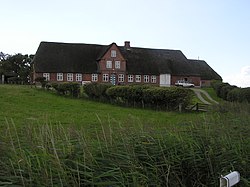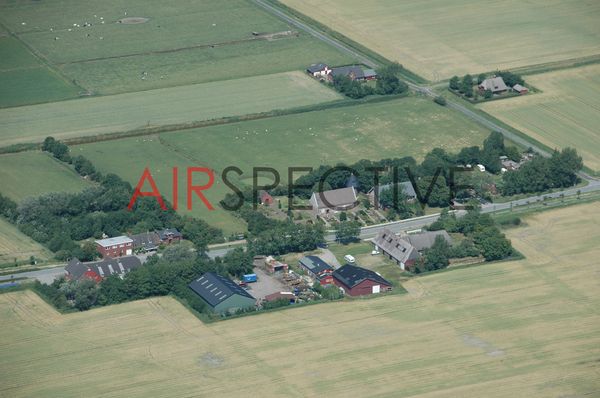Ockholm
Ockholm ( Frisian: e Hoolme, Danish: Okholm ) is a municipality in the district of North Friesland Schleswig -Holstein.
- 3.1 Municipal Council
- 3.2 Mayor
- 5.1 Structures
- 6.1 traffic
Geography
Ockholm located on the North Sea coast in the North Frisian march in the Region Central North Frisia.
Besides the main town, has the districts Schlüttsiel Bongsiel and the southern part of the Hauke- sharks - polder in the municipality.
History
Ockholm formerly belonged to the Second Marcellus 1362 defunct Beltringharde. After the first big Mandränke it was only a holm. Ockholm was first mentioned in the safe interest rate book of the Bishop of Schleswig in 1462 as one of 16 mounds existing place of Norder Goes Harde. The name probably means island of the Ocke. Archaeological findings show that in addition to some agriculture especially Salztorfabbau of 11 was operated by the 14th century until the silting up of the former Moore after the flooding of the Marcellus this branch of labor put an end to.
1515 Holm was surrounded by a dike and thereby made simultaneously with the mainland. The adjacent Langenhorner age polder polder and Sterdebüller were probably already completed 40 years earlier. After reclamation, a church was built. Through several storm surges the projecting peninsula was always in danger, mainly because they hardly had foreland. Wehlen the old outer dike evidence of repeated dike breaches. Dispute with the neighboring communities because of the dike entertainment meant that necessary repairs of the overtaxed residents could not be performed.
The Burchardiflut 1634 broke through the dikes, the Ockholmer polder was flooded, destroyed the church and 400 people lost their lives. The western sea wall was almost completely destroyed. Since it considered that the repair of the middle dikes to protect the hinterland as a priority, was only begun in 1639 by King Christian IV of Denmark, a large portion of the embank Koog again. The dike line was shortened and redeployed. The Eindeichungsarbeiten were completed in 1641. The 800 Demat become ownerless by the storm surge country came into the possession of the king, so that also took over the high dyke loads. Later these lands received the Chamberlain Burchard of Ahlefeldt. 1647 a new church was built.
1735 construction was started on Bongsieler channel for drainage of ten polders. Over the following centuries more polders were around the polder dikes Ockholmer: 1577 Waygaarder polder, 1652 Blumenkoog, 1799 Louise - Russias - polder, 1926, the Sönke -Nissen - polder and 1959, the Hauke- sharks - polder. After the 1962 storm surge Ockholm received a second dike line that protects the lying mostly below sea level polder. The area between the dikes was preserved as a wetland.
During the Third Reich was in Ockholm a Reich Labor Service camp for dike workers. In the 1950s Ockholm received electricity and water connection within the program North.
Port
1579 laid Flensburg merchants at a port in Ockholm after they had been forbidden to use Husum Harbour. However, the port gained no great importance, since the Flensburg soon were driving back from Husum from trade. The harbor was lost in the following storm surges. In 1766 the Flensburg Council relied on the old port privileges and taught all Husum protests in defiance of a port on a Bongsiel, where the goods and should be landed in Holland. However, the bad roads proved by the especially in winter insufficient drained polders as too burdensome.
In 1959, the port Schlüttsiel was built on the edge of Hauke- sharks - polder. From there, there are ferry connections to several holms and to Amrum.
Policy
Municipal council
In the local elections on May 26, 2013, the voters Community Ockholm (WHO ) has again received all nine seats in the municipal council. The turnout was 61.9 percent.
Mayoress
For the election period 2013-2018 Claudia Brandy (WHO ) was re-elected mayor.
Religion / Church
The majority of the population is Protestant faith. Today's located in the town center church to Holy Cross is a church of the citizens Lutheran faith. Typical of North Frisia is the off the church building standing wooden belfry (bell stack ).
Culture and sights
Structures
The settlement is situated on 14 mounds, embankments, which are intended to protect the buildings on it from storm surges. Among the most interesting buildings include the numerous individual settlements on the mounds. These are a relic of the past, as Ockholm was still a holm in the midst of the Wadden Sea. A special role takes the Peter Warf. She was among other things, a film adaptations of Theodor Storm novella The Ghost Rider from 1978 to cinematic glory. In keeping with the title role of the film, the Hofeigentümer Deichgrafen were in real life is often the Ockholmer Koogs.
After the Burchardiflut the 1555 -built "Holy Cross Church " which was probably located outside the present-day sea dike destroyed, in 1647 the successor building was built as a church hall on the Kirchwarft. The stones for the church came from the 1629 spent Mettenhof woman in Bordelum and the place were donated by the king. Pulpit and baptismal font are from the 1634 defunct Church of Evensbüll of beach.
Economy and infrastructure
The economic structure was coined a long time by agriculture.
Meanwhile, tourism is an important source of income for the community. Dominating here is the vacation home rental. In the district Bongsiel is a far into the region known restaurant at home. The multi-awarded by the magazine The Gourmet House is best known for its cuisine regional specialties.
Businesses Artisan active are more locally based. The oldest company of the village is the " company Christian Breckling ". It is the fifth generation led by Uwe Martin Nissen. It is an agricultural engineering wrought with attached gas station.
Traffic
The community is best in individual transport accessible. The road access is primarily done through what is known Bäderstraße which branches north of Bredstedt of the B 5 in a westerly direction. After about ten kms on this route to reach the town center of the community.
In public transport the congregation from the direction of Long Horn is achievable. The travel times of buses, however, are geared largely on student transportation to and from the local school and run thus only appropriate times of the day and not on weekends and during school holidays. The district Schlüttsiel is something better connected. Thither runs twice a day ( including weekends ), a bus transport and tariff association of North Friesland Regional Niebüll. This route is operated to time by the company car power.









.JPG/220px-Ockholm_Peterswarf_(Deichgrafenhof).JPG)